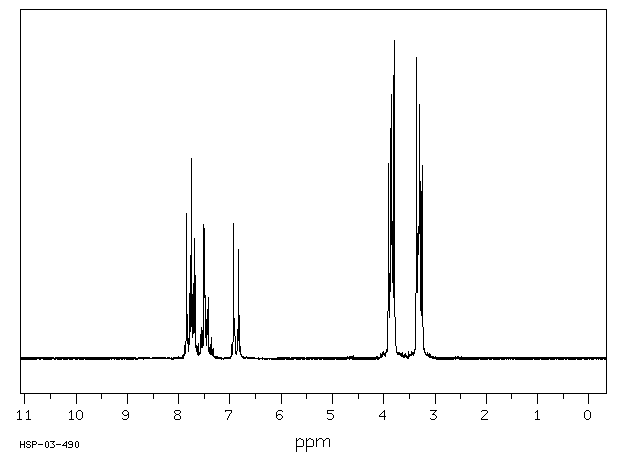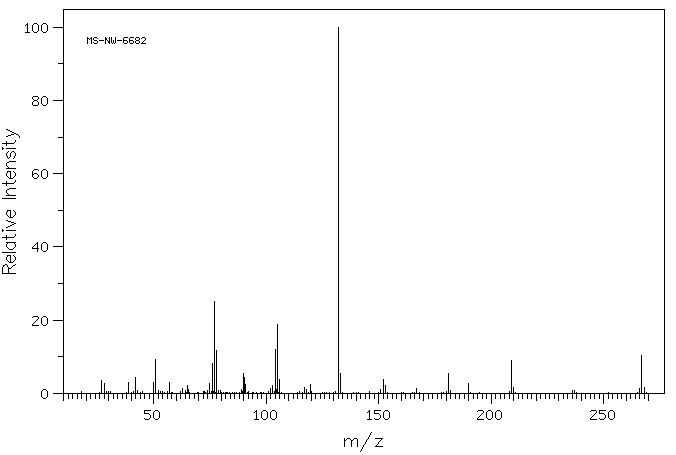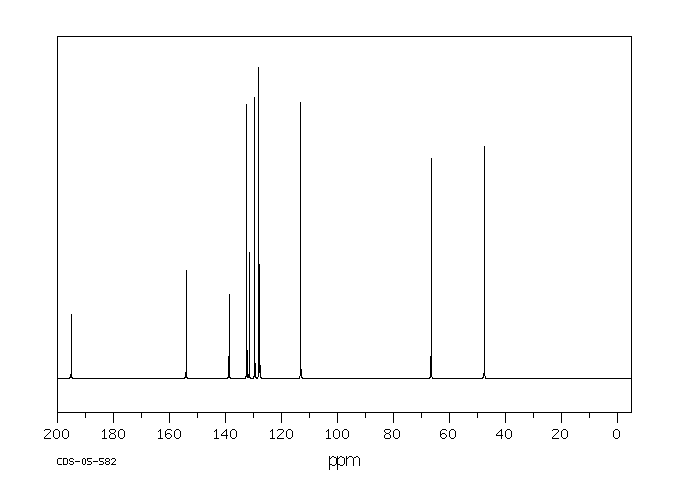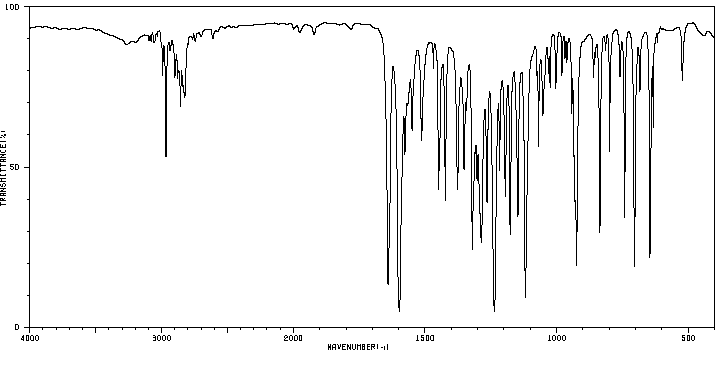4-吗啉二苯甲酮 | 24758-49-4
中文名称
4-吗啉二苯甲酮
中文别名
4-吗啉苯甲酮
英文名称
(4-morpholinophenyl)phenylmethanone
英文别名
4-morpholinobenzophenone;N-(4-benzoylphenyl)morpholine;(4-morpholin-4-ylphenyl)-phenylmethanone
CAS
24758-49-4
化学式
C17H17NO2
mdl
MFCD00006167
分子量
267.327
InChiKey
CGCQHMFVCNWSOV-UHFFFAOYSA-N
BEILSTEIN
——
EINECS
——
-
物化性质
-
计算性质
-
ADMET
-
安全信息
-
SDS
-
制备方法与用途
-
上下游信息
-
文献信息
-
表征谱图
-
同类化合物
-
相关功能分类
-
相关结构分类
物化性质
-
熔点:142-145 °C
-
沸点:410.51°C (rough estimate)
-
密度:1.0690 (rough estimate)
-
稳定性/保质期:
在常温常压下稳定,应避免接触强氧化剂。
计算性质
-
辛醇/水分配系数(LogP):2.7
-
重原子数:20
-
可旋转键数:3
-
环数:3.0
-
sp3杂化的碳原子比例:0.235
-
拓扑面积:29.5
-
氢给体数:0
-
氢受体数:3
安全信息
-
安全说明:S24/25
-
海关编码:2934999090
-
储存条件:将物品存放在密封容器中,并储存在阴凉、干燥的地方。
SDS
| Name: | 4-Morpholinobenzophenone 99% Material Safety Data Sheet |
| Synonym: | |
| CAS: | 24758-49-4 |
Synonym:
Section 2 - COMPOSITION, INFORMATION ON INGREDIENTS
| CAS# | Chemical Name | content | EINECS# |
| 24758-49-4 | 4-Morpholinobenzophenone | 99 | 246-447-7 |
Risk Phrases: None Listed.
Section 3 - HAZARDS IDENTIFICATION
EMERGENCY OVERVIEW
The toxicological properties of this material have not been fully investigated.
Potential Health Effects
Eye:
May cause eye irritation.
Skin:
May cause skin irritation.
Ingestion:
May cause irritation of the digestive tract. The toxicological properties of this substance have not been fully investigated.
Inhalation:
May cause respiratory tract irritation. The toxicological properties of this substance have not been fully investigated.
Chronic:
No information found.
Section 4 - FIRST AID MEASURES
Eyes: Flush eyes with plenty of water for at least 15 minutes, occasionally lifting the upper and lower eyelids. Get medical aid immediately.
Skin:
Get medical aid. Flush skin with plenty of water for at least 15 minutes while removing contaminated clothing and shoes. Wash clothing before reuse.
Ingestion:
If victim is conscious and alert, give 2-4 cupfuls of milk or water.
Never give anything by mouth to an unconscious person. Get medical aid immediately.
Inhalation:
Remove from exposure and move to fresh air immediately. If not breathing, give artificial respiration. If breathing is difficult, give oxygen. Get medical aid.
Notes to Physician:
Section 5 - FIRE FIGHTING MEASURES
General Information:
As in any fire, wear a self-contained breathing apparatus in pressure-demand, MSHA/NIOSH (approved or equivalent), and full protective gear. During a fire, irritating and highly toxic gases may be generated by thermal decomposition or combustion.
Extinguishing Media:
Use agent most appropriate to extinguish fire. Use water spray, dry chemical, carbon dioxide, or appropriate foam.
Section 6 - ACCIDENTAL RELEASE MEASURES
General Information: Use proper personal protective equipment as indicated in Section 8.
Spills/Leaks:
Clean up spills immediately, observing precautions in the Protective Equipment section. Sweep up or absorb material, then place into a suitable clean, dry, closed container for disposal. Avoid generating dusty conditions. Provide ventilation.
Section 7 - HANDLING and STORAGE
Handling:
Wash thoroughly after handling. Remove contaminated clothing and wash before reuse. Use with adequate ventilation. Minimize dust generation and accumulation. Avoid contact with eyes, skin, and clothing. Keep container tightly closed. Avoid ingestion and inhalation.
Storage:
Store in a tightly closed container. Store in a cool, dry, well-ventilated area away from incompatible substances.
Section 8 - EXPOSURE CONTROLS, PERSONAL PROTECTION
Engineering Controls:
Facilities storing or utilizing this material should be equipped with an eyewash facility and a safety shower. Use adequate ventilation to keep airborne concentrations low.
Exposure Limits CAS# 24758-49-4: Personal Protective Equipment Eyes: Wear appropriate protective eyeglasses or chemical safety goggles as described by OSHA's eye and face protection regulations in 29 CFR 1910.133 or European Standard EN166.
Skin:
Wear appropriate protective gloves to prevent skin exposure.
Clothing:
Wear appropriate protective clothing to prevent skin exposure.
Respirators:
A respiratory protection program that meets OSHA's 29 CFR 1910.134 and ANSI Z88.2 requirements or European Standard EN 149 must be followed whenever workplace conditions warrant respirator use.
Section 9 - PHYSICAL AND CHEMICAL PROPERTIES
Physical State: Powder
Color: yellow
Odor: Not available.
pH: Not available.
Vapor Pressure: Not available.
Viscosity: Not available.
Boiling Point: Not available.
Freezing/Melting Point: 138.00 - 141.00 deg C
Autoignition Temperature: Not available.
Flash Point: Not available.
Explosion Limits, lower: Not available.
Explosion Limits, upper: Not available.
Decomposition Temperature:
Solubility in water:
Specific Gravity/Density:
Molecular Formula: C17H17NO2
Molecular Weight: 267.32
Section 10 - STABILITY AND REACTIVITY
Chemical Stability:
Stable under normal temperatures and pressures.
Conditions to Avoid:
Incompatible materials, dust generation, strong oxidants.
Incompatibilities with Other Materials:
Strong oxidizing agents.
Hazardous Decomposition Products:
Nitrogen oxides, carbon monoxide, carbon dioxide.
Hazardous Polymerization: Has not been reported
Section 11 - TOXICOLOGICAL INFORMATION
RTECS#:
CAS# 24758-49-4 unlisted.
LD50/LC50:
Not available.
Carcinogenicity:
4-Morpholinobenzophenone - Not listed by ACGIH, IARC, or NTP.
Section 12 - ECOLOGICAL INFORMATION
Section 13 - DISPOSAL CONSIDERATIONS
Dispose of in a manner consistent with federal, state, and local regulations.
Section 14 - TRANSPORT INFORMATION
IATA
Not regulated as a hazardous material.
IMO
Not regulated as a hazardous material.
RID/ADR
Not regulated as a hazardous material.
Section 15 - REGULATORY INFORMATION
European/International Regulations
European Labeling in Accordance with EC Directives
Hazard Symbols: Not available.
Risk Phrases:
Safety Phrases:
S 24/25 Avoid contact with skin and eyes.
S 28A After contact with skin, wash immediately with
plenty of water.
S 37 Wear suitable gloves.
S 45 In case of accident or if you feel unwell, seek
medical advice immediately (show the label where
possible).
WGK (Water Danger/Protection)
CAS# 24758-49-4: No information available.
Canada
None of the chemicals in this product are listed on the DSL/NDSL list.
CAS# 24758-49-4 is not listed on Canada's Ingredient Disclosure List.
US FEDERAL
TSCA
CAS# 24758-49-4 is not listed on the TSCA inventory.
It is for research and development use only.
SECTION 16 - ADDITIONAL INFORMATION
N/A
上下游信息
-
上游原料
中文名称 英文名称 CAS号 化学式 分子量 4-苯基吗啉 4-Phenylmorpholine 92-53-5 C10H13NO 163.219 4-(4-碘苯基)吗啉 4-(4-iodophenyl)morpholine 87350-77-4 C10H12INO 289.116 4-(4-溴苯基)吗啉 4-bromophenyl-morpholine 30483-75-1 C10H12BrNO 242.115 -
下游产品
中文名称 英文名称 CAS号 化学式 分子量 —— 4-dimethylamino-4'-morpholinotriphenylmethanol —— C25H28N2O2 388.51 —— 4-diethylamino-4'-morpholinotriphenylmethanol 307926-99-4 C27H32N2O2 416.563 —— 1-(4-morpholin-4-ylphenyl)-1,2,2-triphenylethene 919789-74-5 C30H27NO 417.55 4-[4-[2-(4-吗啉-4-基苯基)-1,2-二苯基乙烯基]苯基]吗啉 4,4'-[(1,2-Diphenylethene-1,2-diyl)di(4,1-phenylene)]bis(morpholine) 919789-61-0 C34H34N2O2 502.656 —— 4-morpholino-4'-pyrrolidinotriphenylmethanol 307927-02-2 C27H30N2O2 414.547 —— 4-morpholino-4'-piperidinotriphenylmethanol 307927-04-4 C28H32N2O2 428.574 1-苯基-1-(4-吗啉-4-基)苯基-丙-2-炔-1-醇 1-phenyl-1-(4-morpholin-4-yl)phenyl-prop-2-yn-1-ol 194940-93-7 C19H19NO2 293.365
反应信息
-
作为反应物:描述:4-吗啉二苯甲酮 在 乙二醇二甲醚 、 RuH2(CO)(PPh3)3 、 1,4-丁二醇 作用下, 以 乙二醇二甲醚 为溶剂, 反应 24.0h, 以68%的产率得到(4-morpholinophenyl)(phenyl)methanol参考文献:名称:氨基和酰胺基取代苯乙酮的钌催化转移氢化摘要:报道了富含电子的氨基取代苯乙酮的钌催化转移氢化。还原剂、配体、碱和溶剂的变化允许反应优化。一个关键发现是使用 1,4-丁二醇作为不可逆还原剂,这显着提高了转化率。探索了一系列氨基和酰胺基取代的芳基酮,它们都以良好的收率得到了相应的醇,这表明该方法具有更广泛的适用性。DOI:10.1002/ejoc.201301020
-
作为产物:参考文献:名称:High Pressure Organic Chemistry; XI.1A New Convenient Synthesis of Aromatic Amines from Activated Phenols摘要:含有电子吸引取代基的芳基三氟甲磺酸酯在回流的乙腈中或在10千巴压力下与胺高效反应,生成多种芳香胺。DOI:10.1055/s-1990-27118
文献信息
-
A General Palladium-Phosphine Complex To Explore Aryl Tosylates in the N-Arylation of Amines: Scope and Limitations作者:Pui Ying Choy、Kin Ho Chung、Qingjing Yang、Chau Ming So、Raymond Wai-Yin Sun、Fuk Yee KwongDOI:10.1002/asia.201800575日期:2018.9.4heterocycles such as indole, carbazole, pyrrole, 10‐phenothiazine, and 10‐phenoxazine were shown to be feasible coupling partners under this catalytic system. The described reaction conditions tolerate a wide range of functional groups and allow an array of aromatic amines as well as unsymmetrical amine products to be easily accessed from the various phenolic derivatives. Interestingly, this catalyst提出了使用芳基和杂芳基甲苯磺酸盐对各种胺进行单选择性N-芳基化反应的范围和局限性。空气稳定且易于接近的Pd(OAc)2 / CM-phos CM-phos = 2- [2-(二环己基膦基)苯基] -1-甲基-1 H-吲哚}催化剂体系能够处理各种芳基甲苯磺酸酯底物以及胺亲核试剂,包括伯和仲环状/无环脂族胺和苯胺。在这种催化体系下,含NH的杂环如吲哚,咔唑,吡咯,10-吩噻嗪和10-吩恶嗪被证明是可行的偶联伙伴。所描述的反应条件容许宽范围的官能团,并允许从各种酚衍生物容易地获得一系列的芳族胺以及不对称胺产物。有趣的是,该催化剂体系甚至提供了在水介质中进行反应的机会。我们还报道了旋光性α-中心手性胺与芳基甲苯磺酸盐的分子间偶联,而没有削弱对映体的纯度。
-
Well‐Defined Allylnickel Chloride/N‐Heterocyclic Carbene [(NHC)Ni(allyl)Cl] Complexes as Highly Active Precatalysts for CN and CS Cross‐Coupling Reactions作者:María José Iglesias、Auxiliadora Prieto、M. Carmen NicasioDOI:10.1002/adsc.201000223日期:2010.10.9The room temperature Buchwald–Hartwig amination of heteroaromatic chlorides has been achieved using the sterically bulky allylnickel chloride/N-heterocyclic carbene [(IPr)Ni(allyl)Cl] complex as a well-defined precatalyst. Arylation of aromatic thiols, affording high yields of products under low catalyst loadings, has also been promoted with the same complex.
-
Nickel-catalyzed cross-coupling of aryltrimethylammonium triflates and amines作者:Xue-Qi Zhang、Zhong-Xia WangDOI:10.1039/c3ob41989d日期:——Nickel-catalyzed cross-coupling of aryltrimethylammonium triflates and amines was carried out under mild conditions. The reaction has a broad scope of substrates and can be performed by a one-pot procedure from an aryldimethylamine.
-
A Highly Versatile Catalyst System for the Cross-Coupling of Aryl Chlorides and Amines作者:Rylan J. Lundgren、Antonia Sappong-Kumankumah、Mark StradiottoDOI:10.1002/chem.200902316日期:2010.2.8air‐stable P,N ligands enable the cross‐coupling of aryl and heteroaryl chlorides, including those bearing as substituents enolizable ketones, ethers, esters, carboxylic acids, phenols, alcohols, olefins, amides, and halogens, to a diverse range of amine and related substrates that includes primary alkyl‐ and arylamines, cyclic and acyclic secondary amines, NH imines, hydrazones, lithium amide, and ammonia2-(二-的合成叔- -butylphosphino)ñ,Ñ二甲基苯胺(L1,71%)和2-(二-1- adamantylphosphino) - ñ,Ñ二甲基苯胺(L2,74%),和它们的应用据报道在布赫瓦尔德-哈特维格胺的胺化反应。与[Pd(烯丙基)Cl] 2或[Pd(肉桂基)Cl] 2组合,这些结构简单且稳定的P,N配体可实现芳基和杂芳基氯化物的交叉偶联,包括带有可取代的酮,醚,酯,羧酸,酚,醇,烯烃,酰胺和卤素的取代基。胺和相关的基板的一个不同的范围,其包括初级烷基-和芳基胺,环状和非环状仲胺,N ħ亚胺,腙,氨基锂,和氨。在许多情况下,反应可以在低催化剂负载量(0.5–0.02 mol%Pd)下进行,且具有出色的官能团耐受性和化学选择性。还报道了涉及1,4-溴氯苯和碘苯的交叉偶联反应的例子。在相似的条件下,使用Pd(OAc)2可获得较差的催化性能,PdCl 2,[PdCl 2(cod)](cod
-
Efficient C-N and C-S Bond Formation Using the Highly Active [Ni(allyl)Cl(IPr*<sup>OMe</sup>)] Precatalyst作者:Anthony R. Martin、David J. Nelson、Sébastien Meiries、Alexandra M. Z. Slawin、Steven P. NolanDOI:10.1002/ejoc.201402022日期:2014.5Two new [Ni(allyl)Cl(NHC)] complexes with the bulky yet flexible N-heterocyclic carbene (NHC) ligands IPr* N,N'-bis[2,6-bis(diphenylmethyl)-4-methylphenyl]imidazole-2-ylidene} and IPr*OMe N,N'-bis[2,6-bis(diphenylmethyl)-4-methoxyphenyl]imidazol-2-ylidene} are reported. These complexes were employed in the amination and sulfination of aryl halide species and were shown to perform well in these reactions
表征谱图
-
氢谱1HNMR
-
质谱MS
-
碳谱13CNMR
-
红外IR
-
拉曼Raman
-
峰位数据
-
峰位匹配
-
表征信息
同类化合物
(βS)-β-氨基-4-(4-羟基苯氧基)-3,5-二碘苯甲丙醇
(S,S)-邻甲苯基-DIPAMP
(S)-(-)-7'-〔4(S)-(苄基)恶唑-2-基]-7-二(3,5-二-叔丁基苯基)膦基-2,2',3,3'-四氢-1,1-螺二氢茚
(S)-盐酸沙丁胺醇
(S)-3-(叔丁基)-4-(2,6-二甲氧基苯基)-2,3-二氢苯并[d][1,3]氧磷杂环戊二烯
(S)-2,2'-双[双(3,5-三氟甲基苯基)膦基]-4,4',6,6'-四甲氧基联苯
(S)-1-[3,5-双(三氟甲基)苯基]-3-[1-(二甲基氨基)-3-甲基丁烷-2-基]硫脲
(R)富马酸托特罗定
(R)-(-)-盐酸尼古地平
(R)-(-)-4,12-双(二苯基膦基)[2.2]对环芳烷(1,5环辛二烯)铑(I)四氟硼酸盐
(R)-(+)-7-双(3,5-二叔丁基苯基)膦基7''-[((6-甲基吡啶-2-基甲基)氨基]-2,2'',3,3''-四氢-1,1''-螺双茚满
(R)-(+)-7-双(3,5-二叔丁基苯基)膦基7''-[(4-叔丁基吡啶-2-基甲基)氨基]-2,2'',3,3''-四氢-1,1''-螺双茚满
(R)-(+)-7-双(3,5-二叔丁基苯基)膦基7''-[(3-甲基吡啶-2-基甲基)氨基]-2,2'',3,3''-四氢-1,1''-螺双茚满
(R)-(+)-4,7-双(3,5-二-叔丁基苯基)膦基-7“-[(吡啶-2-基甲基)氨基]-2,2”,3,3'-四氢1,1'-螺二茚满
(R)-3-(叔丁基)-4-(2,6-二苯氧基苯基)-2,3-二氢苯并[d][1,3]氧杂磷杂环戊烯
(R)-2-[((二苯基膦基)甲基]吡咯烷
(R)-1-[3,5-双(三氟甲基)苯基]-3-[1-(二甲基氨基)-3-甲基丁烷-2-基]硫脲
(N-(4-甲氧基苯基)-N-甲基-3-(1-哌啶基)丙-2-烯酰胺)
(5-溴-2-羟基苯基)-4-氯苯甲酮
(5-溴-2-氯苯基)(4-羟基苯基)甲酮
(5-氧代-3-苯基-2,5-二氢-1,2,3,4-oxatriazol-3-鎓)
(4S,5R)-4-甲基-5-苯基-1,2,3-氧代噻唑烷-2,2-二氧化物-3-羧酸叔丁酯
(4S,4''S)-2,2''-亚环戊基双[4,5-二氢-4-(苯甲基)恶唑]
(4-溴苯基)-[2-氟-4-[6-[甲基(丙-2-烯基)氨基]己氧基]苯基]甲酮
(4-丁氧基苯甲基)三苯基溴化磷
(3aR,8aR)-(-)-4,4,8,8-四(3,5-二甲基苯基)四氢-2,2-二甲基-6-苯基-1,3-二氧戊环[4,5-e]二恶唑磷
(3aR,6aS)-5-氧代六氢环戊基[c]吡咯-2(1H)-羧酸酯
(2Z)-3-[[(4-氯苯基)氨基]-2-氰基丙烯酸乙酯
(2S,3S,5S)-5-(叔丁氧基甲酰氨基)-2-(N-5-噻唑基-甲氧羰基)氨基-1,6-二苯基-3-羟基己烷
(2S,2''S,3S,3''S)-3,3''-二叔丁基-4,4''-双(2,6-二甲氧基苯基)-2,2'',3,3''-四氢-2,2''-联苯并[d][1,3]氧杂磷杂戊环
(2S)-(-)-2-{[[[[3,5-双(氟代甲基)苯基]氨基]硫代甲基]氨基}-N-(二苯基甲基)-N,3,3-三甲基丁酰胺
(2S)-2-[[[[[((1S,2S)-2-氨基环己基]氨基]硫代甲基]氨基]-N-(二苯甲基)-N,3,3-三甲基丁酰胺
(2S)-2-[[[[[[((1R,2R)-2-氨基环己基]氨基]硫代甲基]氨基]-N-(二苯甲基)-N,3,3-三甲基丁酰胺
(2-硝基苯基)磷酸三酰胺
(2,6-二氯苯基)乙酰氯
(2,3-二甲氧基-5-甲基苯基)硼酸
(1S,2S,3S,5S)-5-叠氮基-3-(苯基甲氧基)-2-[(苯基甲氧基)甲基]环戊醇
(1S,2S,3R,5R)-2-(苄氧基)甲基-6-氧杂双环[3.1.0]己-3-醇
(1-(4-氟苯基)环丙基)甲胺盐酸盐
(1-(3-溴苯基)环丁基)甲胺盐酸盐
(1-(2-氯苯基)环丁基)甲胺盐酸盐
(1-(2-氟苯基)环丙基)甲胺盐酸盐
(1-(2,6-二氟苯基)环丙基)甲胺盐酸盐
(-)-去甲基西布曲明
龙蒿油
龙胆酸钠
龙胆酸叔丁酯
龙胆酸
龙胆紫-d6
龙胆紫










